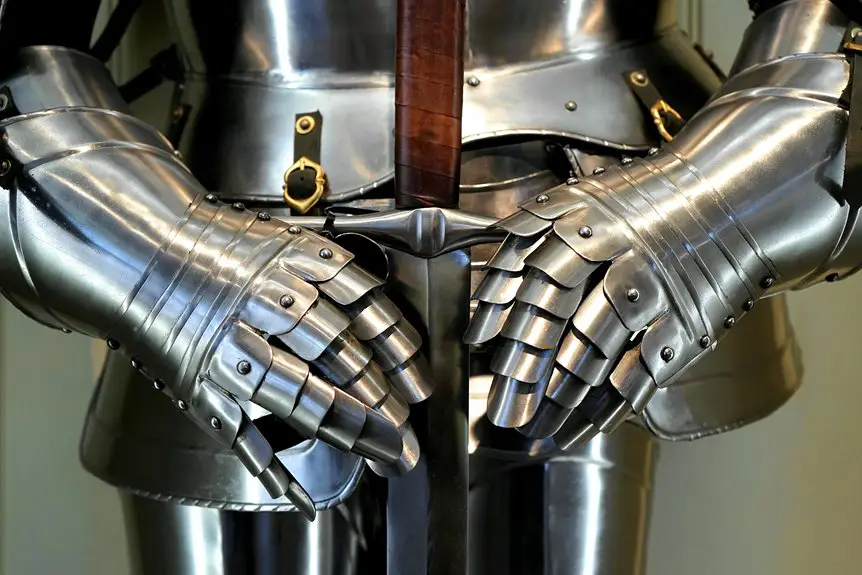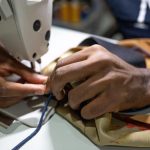Imagine the heat building up under your armor as sweat clings to your skin, slowing you down and making every move uncomfortable. You need fabrics that don’t just sit there but actively pull moisture away and let air circulate. Choosing the right material can mean the difference between irritation and endurance. So, how do you find the perfect balance of breathability and protection when every layer counts?
Table of Contents
Key Takeaways
- Moisture-wicking synthetic fibers like polyester and nylon keep skin dry by quickly pulling sweat away from the body.
- Fabrics with capillary action channels enhance airflow and promote rapid evaporation, cooling the wearer effectively.
- Lightweight, stretchy materials such as Under Armour HeatGear and Nike Dri-Fit provide breathability and freedom of movement.
- Layered designs combining breathable fabrics with ergonomic seams reduce chafing and improve comfort under armor.
- Antimicrobial and quick-drying fabrics prevent odor and bacterial growth during extended wear in protective gear.
Importance of Moisture Wicking in Protective Gear
Although protective gear shields you from external threats, it can also trap heat and moisture, making it uncomfortable and potentially hazardous. That’s why moisture management is essential in your protective clothing.
When your gear efficiently wicks sweat away from your skin, it helps maintain skin comfort by preventing irritation, chafing, and overheating. You’ll notice you stay drier and cooler, even during intense physical activity.
Proper moisture-wicking fabrics pull sweat to the outer layer, where it evaporates quickly. This not only keeps you comfortable but also supports your body’s natural cooling process.
Without effective moisture management, sweat can accumulate, increasing the risk of skin infections and reducing your overall performance.
Choosing gear with breathable, moisture-wicking properties guarantees you stay protected and comfortable under pressure.
Advantages of Synthetic Fibers for Body Armor Liners
When you choose synthetic fibers for body armor liners, you get materials designed to enhance durability and comfort simultaneously.
Synthetic advantages include superior resistance to wear and tear, ensuring your gear lasts through demanding conditions. These fibers also excel in moisture management, keeping you dry and comfortable by efficiently wicking sweat away from your skin.
Synthetic fibers resist wear and wick moisture, keeping your gear durable and you comfortably dry.
The fiber performance in synthetic materials supports flexibility, allowing your armor liner to move with you without restriction. Additionally, synthetics dry quickly, reducing the risk of bacterial growth and odor.
Their lightweight nature means you won’t feel weighed down during extended wear. By opting for synthetic fibers, you invest in liners that balance protection with breathability, maximizing your comfort and endurance beneath body armor.
Innovative Fabric Technologies Enhancing Breathability
You’ll find that fabrics using capillary action move moisture away from your skin, keeping you dry and comfortable.
Some of these technologies even earned Nobel Prizes for their groundbreaking designs.
Let’s explore how these innovations boost breathability in body armor fabrics.
Capillary Action Fabrics
Capillary action fabrics draw moisture away from your skin by using tiny channels woven into the material. This capillary flow moves sweat efficiently, enhancing moisture management and keeping you dry beneath body armor.
When you wear these fabrics, you benefit from:
- Rapid sweat absorption that pulls moisture from your skin.
- Enhanced evaporation, which cools your body quickly.
- Lightweight, breathable layers that don’t trap heat.
- Durable construction maintaining effectiveness after multiple washes.
These fabrics use innovative fiber designs to create micro-pathways, making sure moisture travels away from your skin to the fabric’s surface where it evaporates.
Nobel Prize Innovations
Although fabric technology has advanced steadily, Nobel Prize-winning discoveries have dramatically transformed how breathable materials perform in body armor.
These Nobel Prize discoveries introduced innovative textiles that optimize airflow and moisture management, keeping you cooler and drier under intense conditions. By integrating microscopic fibers and advanced polymers, these textiles enhance breathability without sacrificing protection.
When you choose body armor lined with these innovations, you benefit from fabrics that actively regulate temperature and wick sweat away efficiently. This means less discomfort and improved endurance during prolonged wear.
Thanks to these breakthroughs, manufacturers now create gear that adapts to your body’s needs, ensuring you stay both protected and comfortable. Embracing these innovative textiles elevates your protective experience to a new level of performance.
Comparing Popular Fabrics: Under Armour, Nike Dri-Fit, and P3 Vapor
When choosing breathable fabrics for body armor, understanding how Under Armour, Nike Dri-Fit, and P3 Vapor perform can help you make the best decision.
Here’s a quick breakdown:
- Under Armour comparison shows its HeatGear fabric excels at moisture-wicking and cooling, perfect if you need lightweight comfort.
- Nike Dri FIT benefits include excellent sweat management and stretch, allowing freedom of movement beneath armor.
- P3 Vapor fabric integrates advanced ventilation zones that boost airflow more than traditional synthetics.
- All three fabrics dry quickly, but P3 Vapor’s unique mesh panels enhance breathability considerably during intense activity.
Design Features That Improve Comfort Under Armor
Since you’ll be wearing body armor for extended periods, design features that enhance comfort become essential. One key aspect is fabric layering, which helps regulate temperature and wick moisture away from your skin, keeping you dry and comfortable.
Multiple layers work together to provide breathability without sacrificing protection. Ergonomic designs also play a significant role by contouring to your body’s natural shape, reducing pressure points and allowing greater freedom of movement.
Look for garments with strategically placed seams and stretch panels that prevent chafing and accommodate your range of motion. By choosing breathable fabrics integrated with thoughtful fabric layering and ergonomic designs, you’ll experience less discomfort and fatigue, making those long hours in protective gear much more manageable.
Durability and Care for Breathable Protective Clothing
To keep your breathable protective clothing effective, you need to understand what affects its fabric longevity.
Proper maintenance and washing techniques play an essential role in preserving its durability.
Let’s explore how to care for your gear without compromising its protective qualities.
Fabric Longevity Factors
Although breathable fabrics enhance comfort and protection, their longevity depends heavily on how you care for and use them.
Understanding fabric composition is key—materials with higher wear resistance last longer under stress. To maximize durability, focus on these four factors:
- Rotate your gear regularly to distribute wear evenly.
- Avoid exposing fabrics to harsh environments like excessive heat or chemicals.
- Store your protective clothing in a cool, dry place away from direct sunlight.
- Inspect seams and fabric surfaces frequently for signs of damage or thinning.
Maintenance and Washing
Proper maintenance and washing play an essential role in extending the life of your breathable protective clothing.
To keep your gear in top shape, you need to follow specific fabric care guidelines. Always check the manufacturer’s instructions before washing. Use gentle washing techniques, such as cold water and mild detergents, to prevent damage. Avoid bleach and fabric softeners, as they can degrade the fabric’s breathability and durability.
Hand washing or using a delicate cycle in your machine helps preserve the material’s integrity. After washing, air dry your clothing instead of using a dryer to avoid heat damage.
Selecting Fabrics for Different Weather Conditions and Use Cases
When choosing breathable fabrics for body armor, you need to take into account how different weather conditions and specific use cases affect comfort and performance.
Prioritize weather adaptability and seasonal performance to stay comfortable all year round. Consider these factors:
- Hot weather: Opt for lightweight, moisture-wicking fabrics like mesh or merino wool to enhance breathability and sweat evaporation.
- Cold weather: Choose insulating, moisture-managing materials such as fleece blends that keep you warm without trapping moisture.
- High-activity use: Select stretchy, durable fabrics that provide ventilation and freedom of movement.
- Extended wear: Look for materials with antimicrobial properties to reduce odor and maintain freshness during long shifts.
Frequently Asked Questions
Can Breathable Fabrics Reduce the Risk of Skin Irritation Under Armor?
You’ll find breathable fabric types like moisture-wicking polyester or merino wool help maintain skin health by reducing sweat buildup. They keep your skin dry and comfortable, lowering the risk of irritation when you wear armor for long periods.
Are There Eco-Friendly Breathable Fabric Options for Body Armor Liners?
Like a fresh breeze on a summer day, you can choose eco-friendly liners made from organic cotton and recycled polyester. These fabrics breathe well, keep you comfortable, and reduce environmental impact without sacrificing performance.
How Does Fabric Color Impact Heat Retention Under Protective Gear?
You’ll find that color theory and thermal dynamics show darker fabrics absorb more heat, increasing retention under gear. Lighter colors reflect sunlight, keeping you cooler, so choosing color wisely helps manage your body temperature effectively.
Can Breathable Fabrics Help in Reducing Odor During Extended Wear?
They say, “Prevention is better than cure.” You’ll find breathable fabrics excel in odor control and moisture management, keeping you dry and fresh during extended wear by wicking sweat away and reducing bacteria buildup effectively.
What Layering Strategies Work Best With Breathable Fabrics Beneath Armor?
You should use moisture management layering techniques by wearing a moisture-wicking base layer to keep sweat off your skin, followed by a breathable mid-layer for insulation, ensuring comfort and dryness beneath your armor during extended wear.
- Understanding Silk Charmeuse Weight: a Guide to Momme (19mm, 22MM, Etc.) - June 20, 2025
- How to Properly Care for Charmeuse Fabric: Washing, Drying, and Storing - June 20, 2025
- The Ultimate Guide to Sewing With Silk Charmeuse Fabric - June 20, 2025







